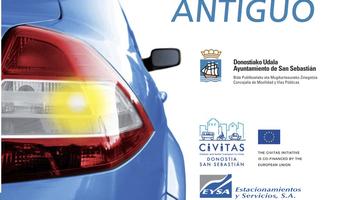Changing parking behaviour
Basic Information
Mobility solution ID
23
Timeline
- complete
Project
Summary
Donostia-San Sebastian introduced a new zoning and pricing strategy to better regulate parking in the city and reduce the number of cars accessing the city centre. Special incentives were developed for high occupancy vehicles to promote car pooling.
Implementing sustainable mobility
At the start of the CIVTAS project a single tariff for on-street and underground parking was in place in a large part of the city centre of Donostia-San Sebastian. The new parking strategy aimed to decrease the number of cars accessing certain destinations through differentiated tariffs according to a new zoning structure.
The main objectives of the measure were to:
- Extend paid-parking zone to all flat areas of the city.
- Implement a new pricing and zoning policy integrating both on-street and underground parking facilities
- Introduce paid parking in business districts
- Implement incentives for high occupancy vehicles (more than two occupants) to promote car pooling
- Reduce the number of car trips towards the city centre and three business districts.
For the business districts a “soft” regulation of parking provisions was foreseen to serve short and mid-stay demand, mainly related to loading /unloading services and visitor parking. These users faced difficulties in finding parking places in the middle of the day when all spaces were already occupied.
Progress
Four Pricing Zones were defined, following a radial criterion, fixing more deterrent, higher to lower rates depending on parking demand in each zone.
- Special Zone: This applies to areas where parking demand is higher. It is the most expensive pricing zone and it is associated with the shortest Maximum Lengths of Stay.
- Red Zone: Also intended for high parking demand areas where parking charges are, however, somewhat cheaper than those of the Special zones.
- Blue Zone: This targets “peripheral” areas with short and medium-term parking demand.
- Green Zone: Meant for the “outlying” areas, in order to avoid the border effect and to provide long-term parking facility in those areas. Prices are more affordable and Maximum Length of Stay is the longest.
The system also established Maximum Lengths of Stay based on the type and level of demand that needs to be met in each zone, namely:
- Up to 90 minutes: in markedly commercial areas.
- Up to 180 minutes: at the borders of commercial areas.
- Up to 300 minutes: in peripheral areas having no demand for short-stay parking and where a low vehicle turnover is expected.
- Up to 540 minutes: in outlying districts where demand for short-stay parking is nil and the number of available parking spaces makes compulsory vehicle turnover unnecessary.
These conditions were combined with 3 tariff bands defined according to the type of user as follows:
- Tariff 1 (normal rates) covers general fees applicable to most users.
- Tariff 2 is for Commercial or Multi-purpose vehicles (e.g. a plumber’s van) performing activities in town. Tariff 2 is 13.50% cheaper than Tariff 1 and establishes no Maximum Stay.
- Tariff 3 applies to Commercial or Multi-purpose Vehicles related to businesses based within the boundaries of the controlled zone (e.g. delivery vans of a supermarket). Tariff 3 is 70% cheaper than Tariff 1 and establishes no Maximum Stay.
As part of the measure, the parking regulation bylaw was modified to reflect the changes in the parking policy. The measure also included the implementation of preferential and reserved areas for high occupancy vehicles (HOV) as a mean to promote car-pooling, considered as powerful tool to reduce congestion. An information campaign explained the changes in the parking policy to the citizens of the respective neighbourhoods.
After the research phase, a series of workshops in the business areas were planned to discuss the foreseen parking regulation in the business districts. During the first workshops several companies expressed their opposition to this measure that would affect their employees. Due to growing controversy in social and political spheres, the commissioning of this part of the measure was first postponed and finally cancelled.
Outcomes
Parking management measures are very sensitive and very often raise strong position from citizens. This was the case in Donostia-San Sebastian, where the extension of the paid parking area was assessed as negative by a majority of the population (59% before the implementation and 75% after it started operating). This was a surprising result, taking into account that with the regulation of parking residents have more parking spaces available to park. However, visitors from other districts may see their parking options limited.
The public opinion seemed also to be independent from the overall mobility improvements driven by the integrated package of CIVITAS measures. The number of cars entering to the CIVITAS corridor were reduced with more than 7.500 cars per day as compared to the before situation. Following the reduction in traffic levels, a decrease in parking demand was experienced, decreasing by a 20% if the situation after the implementation of the measure is compared to the situation before the new parking management scheme started operating.








